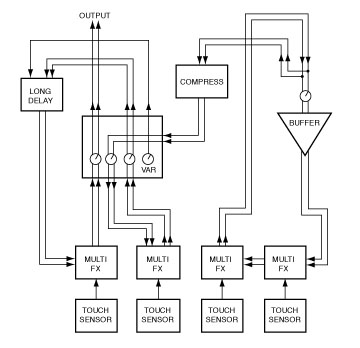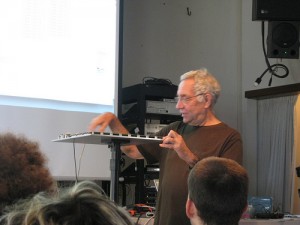 Quando ho scritto questo post, nel 2010 con il titolo di Aidoru (Idol nella translitterazione inglese → giapponese), pensavo che Hatsune Miko sarebbe durata solo qualche anno, sostituita da qualche altro idolo in ologramma, invece è ancora lì, alive & kicking, e soprattutto per niente invecchiata 😛
Quando ho scritto questo post, nel 2010 con il titolo di Aidoru (Idol nella translitterazione inglese → giapponese), pensavo che Hatsune Miko sarebbe durata solo qualche anno, sostituita da qualche altro idolo in ologramma, invece è ancora lì, alive & kicking, e soprattutto per niente invecchiata 😛
Qui lo ripropongo e aggiungo qualche considerazione.
Canta, danza (o perlomeno si muove a tempo), è il più recente idolo dei teenager giapponesi ed è virtuale. Hatsune Miko (初音ミク) ha un vero pubblico, una vera band, ma è, apparentemente, un ologramma. In realtà si tratta di una proiezione 2D su uno schermo trasparente.
La sua voce è sintetizzata tramite il software Vocaloid Yamaha. In effetti Hatsune Miko è il secondo personaggio vocale completo messo a punto per Vocaloid (il primo rilasciato in Giappone) nel 2007 e il suo nome unisce primo (初, hatsu), suono (音, ne) e futuro (Miku ミク). La voce è quella dell’attrice Fujita Saki (藤田 咲) che si è prestata a registrare centinaia di fonemi giapponesi con una intonazione controllata.
Il fenomeno di Hatsune Miko non è il primo di questo genere. Segue la grande notorietà di Kyoko Date (DK-96) che è stato il primo net-idol, nel 1997. Il fenomeno delle star in Giappone risale ai primi anni ’70 e riflette il boom giapponese della cantante francese Sylvie Vartan con il film Cherchez l’idole (1963, in Giappone nel 1964).
Lo sviluppo degli idoli giapponesi è molto interessante.
Negli anni ’70 gli idoli avevano un’aura quasi mistica. Soltanto la parte pubblica della loro vita era nota ed era sempre perfetta e sapientemente orchestrata e la loro personalità visibile era falsa e accuratamente costruita. Nulla si sapeva della loro vita privata, se non alcune notizie essenziali (tipo, un matrimonio) e quello che traspariva del loro privato era altrettanto costruito. Le loro condizioni di lavoro erano pessime: erano strettamente controllati e guadagnavano decisamente poco, perché la maggior parte del denaro andava nelle tasche dei loro produttori, ossia quelli che li creavano.
Negli anni ’80 la condizione degli idoli cominciò ad avvicinarsi a quella della gente comune, in parte perché le condizioni di vita in Giappone erano notevolmente migliorate, ma anche perché il controllo si era leggermente allentato e si permetteva loro di mostrare un po’ della loro personalità. Le major, infatti, iniziavano a sperimentare la competizione fra varie star e quindi alcune differenze dovevano emergere. Un po’ come Beatles e Rolling Stones: questi ultimi apparivano un po’ più selvaggi dei primi e probabilmente lo erano davvero.
Iniziarono anche a guadagnare un po’ di più, ma sempre poco, se paragonato al giro d’affari che creavano.
Gli anni ’90 videro molti cambiamenti. Invece di essere dipinti come delle persone superiori, gli idoli divennero gente comune che aveva solo qualcosa in più (un X-Factor?). In qualche situazione potevano anche essere tristi, un po’ fuori forma e ammettere di aspettare i saldi per comprare i vestiti. Nello stesso tempo, il loro ciclo di vita come idoli divenne più rapido.
Ma il grande salto avvenne quando, vedendo il grande successo dei personaggi di anime e videogames (es. Lara Croft), le major iniziarono a lavorare su personaggi virtuali. L’idea nacque dalla constatazione che il contatto fra i fans e le star era sempre mediato da qualcosa (internet, TV, film, stampa). Non si incontra una star della musica o del cinema per caso in un centro commerciale o al ristorante. E in realtà lo star system non vende una persona, bensì una immagine totalmente idealizzata. La maggior parte dei fans non ha mai visto il proprio idolo in carne ed ossa, ma solo attraverso i media. Una parte riesce a vederlo, da lontano, in qualche concerto o mentre entra in un hotel ed è tutto. Una sparuta minoranza riesce a toccarlo facendosi fare un autografo dopo un lungo appostamento davanti alla sua casa, ma è una quantità trascurabile.
Quello che lo star system giapponese ha capito è che, se le cose stanno così, non è necessario che la star sia una persona vera. Può essere benissimo un personaggio virtuale. Per i fans non cambia proprio niente. E, si noti, alla base di questa idea non ci sono considerazioni economiche. Se è vero che le star virtuali non devono essere pagate, è anche vero che, al loro posto, bisogna pagare dei team di design e animazione che possono costare anche di più. Il punto è che un personaggio virtuale è totalmente controllabile e non pone problemi. Non ha comportamenti censurabili, a meno che non lo si voglia. Non è mai di pessimo umore, non si monta la testa, può lavorare sempre ed essere in TV anche la mattina dopo un concerto, fresco come una rosa.
Considerate, infine, che le star virtuali che sono state create non sono certo attori di teatro avvezzi a confrontarsi con le tragedie shakespeariane e nemmeno musicisti classici, ma, tipicamente, si tratta di cantanti con target adolescenziale. Hanno, al massimo, la profondità concettuale di un Justin Bieber.
Qui vediamo Hatsune Miku insieme a Megurine Luka (ルカ 巡音). Il cognome di quest’ultima combina la parola “Meguri” (巡, “intorno”) e “Ne” (音, “suono”), mentre il nome Luka evoca le omofone parole giapponesi “nagare” (流, “flusso”) e “ka” (歌, “canzone”) o “ka” (香, “profumo”. Il risultato dell’unione di queste parole può quindi essere “flusso di canzoni che si diffondono come profumo”) [da wikipedia con correzioni mie].
Megurine Luka è un passo avanti rispetto a Hatsune Miku. Infatti altro non è che l’incarnazione del terzo applicativo di Vocaloid, lanciato nel 2009 insieme al personaggio che lo rappresenta.
Questa tendenza giapponese ad “incarnare” i software fin dal momento del lancio è unica nel panorama mondiale. In occidente, infatti, l’eventuale incarnazione arriva dopo, quando il software, tipicamente un gioco, ha già raggiunto un successo planetario e allora il personaggio diventa vero, impersonato da un attore/attrice, non virtuale (il caso più emblematico è proprio quello di Lara Croft).



 Lo scorso weekend potrebbe essere ricordato come un momento storico per internet.
Lo scorso weekend potrebbe essere ricordato come un momento storico per internet.